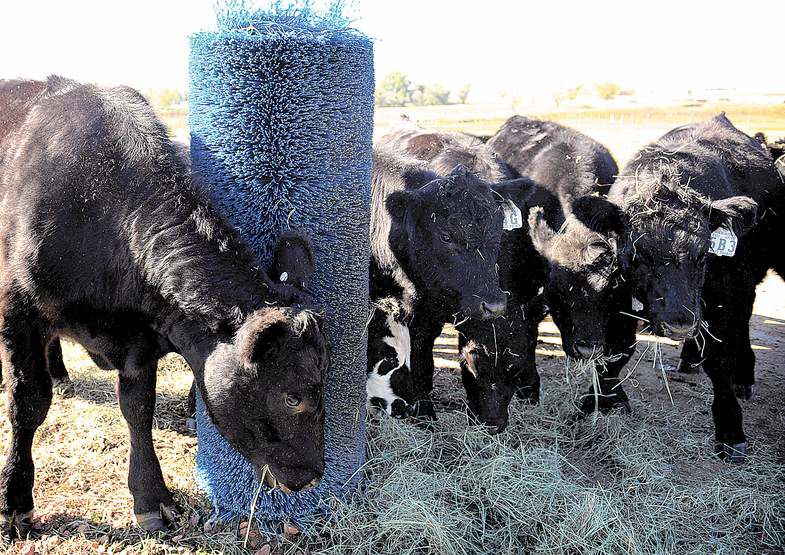Others see trash … He sees treasure
Published 5:00 am Monday, October 17, 2011

- Angus cattle at the Blue Sky Farm in Windsor, Colo., gather around a scratching pole — an old street-sweeper brush that found a new home thanks to Repurposed Materials of Denver. While traditional cow brushes can cost as much as $1,500, these street-sweeper brushes sell for $125 apiece. “The cows love them,” said Zada Steidl, a Windsor rancher.
Where others see garbage, Damon Carson sees possibility.
At Repurposed Materials, his warehouse and yard in Denver, customers can find stacks of folded billboard vinyl, pressure-treated 2-by-6 lumber, 55-gallon barrels, swaths of conveyor belting and tire tread, slabs of snowplow rubber and used brushes from street sweepers.
“Just because it comes to us as a byproduct doesn’t mean it’s obsolete,” says Carson, 39, a former ski bum with the impatient energy and muscular build of someone accustomed to hard, heavy work.
That’s his credo. Like so many Colorado transplants, Carson first came here intending to spend a winter as a ski bum and never left.
To pay the bills and support a life that eventually included a wife and three children, he and a friend ran a trash-pickup business serving Eagle and Summit counties. Most of their customers were in the construction business. Carson was astounded at the amount of useful stuff that his clients sent to the dump.
Some of it was clearly reusable, like the padded leather chairs one company tossed into its Dumpster. Some, like discarded roof insulation panels, were less obvious.
Then Carson came up with the idea of a business that rescued and resold usable industrial byproducts. He was thinking big.
“Where repurposing makes the most sense is in taking one highly engineered byproduct from one industry directly to another one,” he said.
“A lot of green businesses need subsidies. This one works because it doesn’t. It makes money. Does repurposing make more sense environmentally or economically? The answer is both. It keeps this stuff out of the landfill, and the cost is one-third what you’d pay for similar spec material.”
For a 14-foot-by-48-foot billboard vinyl, fabricated of high-tech three-ply vinyl made to withstand sun, wind, snow, ice and rain, Carson charges $100.
Ranchers and farmers buy the billboard vinyls to cover towers of hay bales. One customer bought one to shelter his boat in the off-season. Another bought one to cover his garage floor. People use the vinyls as pond liners.
“I look for byproducts that are highly engineered for a big job and become waste for the original industry but is still overengineered for its next use,” Carson said.
One way to research the market is by studying trade magazines. Among the titles in the library of Carson’s office in north Park Hill: Bison World, Utility Contractor, Forage, Sheep!, Midwest Farm, Stormwater and Aviation Fueling.
He examines the advertisements for products whose design or purpose suggests a parallel byproduct. One ranching magazine sells a stationary cow brush for more than $1,500 apiece. At Repurposed Materials, a retired street-sweeping brush — a dead ringer for the $1,500 cow brush — costs $125.
“The cows love them,” said Zada Steidl, a Windsor rancher.
She bought four street-sweeper brushes for her herd and is interested in buying more when the cows shed their winter coats next spring. She laughed out loud at the price difference between the industry-manufactured cow brush and the repurposed street-sweeper brush.
“We’re an industrial thrift store,” Carson says, “but different from Habitat ReStore, because most of this is big, heavy industrial stuff that comes from mines, city sanitation departments, you name it.”
He sells conveyor belts, still coated with dust from mining slag. The used belting sells briskly to horse and cattle owners, who use it to line trailers and ramps for secure footing. People use it as windbreak material. Weightlifters buy it to put under their benches. A professional wrestler recently bought some to cover the floor of his workout facility.
One of Repurposed Material’s biggest sellers, in every sense of the word, is the tires from Arizona’s open-pit copper mines. Each weighs more than 4,000 pounds.
First, Carson removes the tread, which comes off in a heavy strip. Then he cuts the tire in half, as if it were a giant, hollow bagel. Ranchers buy them as stock tanks.
“Pour ’em half full of cement, and what’s waste to the mining industry becomes an overengineered product for livestock,” he says.
“Cows jump in stock tanks, so the metal ones get dented and banged up till they’re wrecked. This stuff is so tough that cattle can stomp all over it without denting it. A bullet couldn’t wreck it. And it won’t freeze in the winter.”






